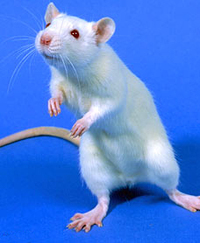 I’ve been hearing more and more people recommending creatine for neurodegenerative disorders, concussions, and brain health, so, I decided to look into it, and wrote a paper on the subject (a condensed version is below). For those who want the quick and dirty, here are my two cents:
I’ve been hearing more and more people recommending creatine for neurodegenerative disorders, concussions, and brain health, so, I decided to look into it, and wrote a paper on the subject (a condensed version is below). For those who want the quick and dirty, here are my two cents:
Creatine plays an important role in energy metabolism (ATP) pathways in the brain. Researchers began to wonder if supplementing with creatine would provide more raw materials to make ATP, and if that would equate to better outcomes in patients with neurodegenerative diseases. The interesting thing that I found in the process of doing my research was that, while rat studies were quite promising, when it came to human clinical trials, creatine was not found to substantially benefit people with ALS, Parkinson’s or Alzheimer’s. It showed possible promise to people with certain forms of muscular dystrophy, not by improving brain health, but through preserving lean muscle mass.
It is very possible that the dose plays a big role in its effects. However, now that I have also completed a lot of other research on neurodegenerative disorders, I understand that brain inflammation is one of the primary mechanisms of many neurodegenerative disorders. Creatine is not considered a potent anti-inflammatory. It’s possible creatine may improve aspects of e
nergy metabolism in the brain, however, unless local and systemic inflammation are addressed, people may not see benefit to creatine supplementation alone. In the case of Alzheimer’s, it has been shown that infectious pathogens including parasites, viruses, and bacteria in the brain actually play a huge role in the genetic expression, inflammation, cognitive decline, and neurodegeneration that occurs. Once again, creatine is not an antibiotic, anti-parasitic or anti-viral.
As long as research continues to look for the magic bullet drug or magic bullet supplement, it will miss the mark. Humans are too complex. It is very easy to get excited about promising research on rats and mice, however, it doesn’t always translate well into humans for numerous reasons. Rats and mice in the laboratory do not have deadlines, financial problems, relationship stress, injuries, constant exposure to air pollution, pesticides, endocrine dysruptors, or diet coke.
It is possible creatine might make a difference in the health of people with neurodegeneration, but most likely, it would need to be combined with a host of other supporting nutrients, herbs, medications, and dietary changes. As research involving brain imaging tools like magnetic resonance spectroscopy, starts looking at changes in various biomarkers in the brains of the living, before and after treatment intervention, we may get better answers.
For those who want an in-depth review of Creatine, here you go!
Creatine Supplementation for Neurodegenerative Disorders
Creatine (Cr) is most commonly known as a sports performance-enhancing supplement, however it may have potential in slowing down the progression of disease in neurodegenerative disorders. This blog post discusses the pharmacological principles, molecular mechanisms of action, and neuroprotective effects of Cr in the brain demonstrated in many cellular and animal studies. Clinical trials on the effects of Cr supplementation in several neurodegenerative diseases will also be reviewed.
Creatine is a naturally occurring compound in the human body. An average of one to two grams of Cr are synthesized in the liver and kidneys daily. Approximately ninety-five percent of the body’s Cr is found in the skeletal muscles. The other five percent is found in the brain, liver, kidney, pancreas and testes. Creatine is also consumed in the diet, primarilythrough meats and fish (Persky and Brazeau, 2001).
Creatine is important in the production of adenosine triphosphate (ATP), an important molecule for the transfer and release of energy. By increasing the available ATP in muscles, athletes can delay muscle fatigue and lactic acid build-up. Supplementation with Cr has been shown to improve performance in resistance training, high intensity interval training, sprinting, swimming and biking (Kendall et al. 2009; Persky and Brazeau, 2001). Typically dosing for athletes starts with a loading phase of five grams of Cr four times a day for two to seven days, followed by a maintenance dose of three to five grams per day. Creatine absorption is enhanced by carbohydrates and the release of insulin. Levels will stay elevated in the body thirty days after discontinuing supplementation (Persky and Brazeau, 2001).
Creatine supplementation has been studied in Alzheimer’s Disease (AD), Amyotrophic Lateral Sclerosis (ALS), Huntington’s Disease (HD), and Parkinson’s Disease (PD). While animal studies repeatedly show significant neuroprotective effects, human studies have had mixed results. In AD neurodegeneration is caused by the accumulation of extracellular plaque and intracellular neurofibrillary tangles, and damage to mitochondrial DNA, proteins, and lipids from oxidative stress. Creatine deposits are also seen in the brain during later stages of AD. One hypothesis attributes this to the poor conversion of Cr to PCr by CK due to oxidative stress and mutations in the amyloid precursor protein affecting Cr metabolism and leading to excess Cr accumulation (Burklen et al. 2006). For this reason, Cr supplementation in the late stages of AD may only worsen Cr deposits. However, there is encouraging research suggesting that Cr may be useful in the early stages of AD. One study with AD model rats found Cr supplementation protected hippocampal cells from glutamate toxicity and damage from beta-amyloid plaque deposits (Brewer and Wallimann, 2000). Cellular and animal AD model studies have shown Cr may provide a neuroprotective effect in the early stages of AD by improving mitochondrial function, however, clinical trials are lacking (Adhihetti and Beal, 2008).
Amyotrophic Lateral Sclerosis is characterized by degeneration of the upper and lower motor neurons in the central nervous system. The decrease in neuronal signaling eventually leads to atrophy and weakness in the muscles. Excess glutamate and reactive oxygen species (ROS) both cause damage to the motor neurons. Cerebral mitochondrial dysfunction, decreased ATP production, and loss of intracellular calcium homeostasis are also factors in the pathogenesis. The pharmacological actions of Cr include promoting ATP production, aiding glutamate uptake by synaptic vesicles, and acting as an antioxidant against ROS (Adhihetty and Beal, 2008; Andres et al. 2008; Gualano et al. 2010). For these reasons, it was hypothesized that Cr supplementation may be beneficial for ALS. Given its well-researched use in building lean muscle mass and increasing muscle energy output, Cr may also delay the progressive muscle weakness seen in ALS. Animal studies of motor neuron degeneration have shown benefits from Cr supplementation that include longer lifespan, decreased motor neuron loss, and improved motor performance (Andreassen et al. 2001; Ellis and Rosenfeld, 2004).
The few clinical trials involving Cr supplementation in ALS patients have been small-scale studies, using 5 grams/day and measured either forced vital capacity or maximum voluntary isometric contraction (MVIC) to determine an effect from Cr. These trials failed to show significant benefit (Ellis and Rosenfeld, 2004). One study measuring MVIC in ALS patients consuming 20 grams/day of Cr for 7 days showed significant improvements in knee and elbow MVIC. The effects decreased when patients dropped to a 3 gram/day maintenance dose (Mazzini et al. 2001). This suggests that the maintenance dosage for healthy athletes may not be adequate for having a therapeutic effect in certain disease populations. A recent pilot study using magnetic resonance spectroscopy (MRS) imaging found a dose-dependant decrease in glutamate concentration in ALS patients taking 15 grams/day of Cr. The effect was not seen at 5 or 10 gram/day dosages, once again, suggesting that higher dosing may be needed for neuroprotective effects to be achieved in neurodegenerative disorders (Atassi et al. 2010). Future research on ALS should include higher dosages of Cr and novel methods for measuring disease progression.
Parkinson’s Disease is caused by degeneration of cells in the substantia nigra, an area of the brain controlling movement. Degeneration causes a loss of dopamine release. Cerebral mitochondrial dysfunction and reduced ATP production are also part of the pathogenesis. The disease leads to uncontrolled movements, tremors, rigidity, bradykinesia and postural instability. There is no known cure. Pharmaceuticals for PD are often aimed at preserving dopamine. A 2006 phase II clinical trial of Cr supplementation in early-phase PD showed enough benefit to warrant further studies, however, a large scale phase III clinical trial was discontinued due to futility. The dosage utilized was 5 grams/day (Adhihetty and Beal, 2008). Currently there is a lack of clinical evidence supporting the use of Cr for PD. If higher doses of Cr prove to be beneficial in other neurodegenerative disease, it may warrant further investigation for PD as well.
Despite all the protective actions of Cr in the brain, and promising animal studies involving Cr supplementation, clinical trials in patients with AD, ALS, and PD are failing to show significant improvements in symptoms and clinical findings. Some researchers have speculated that rat physiology regarding Cr may be different enough from humans that the benefits don’t translate well. Other researchers have pointed out the “Goldilocks Effect” of Cr in rats, indicating that doses that are too low or too high do not have the significant neuroprotective effects at the just-right dose. It is possible that for humans with neurodegenerative disorders, we have not found the right dosing. It is also possible that supplementation with Cr simply doesn’t translate into improved brain utilization of Cr, as in the case for the amino acid glutathione. Supplementation with L-glutathione increased extracellular levels, but not intracellular levels. In order to maximize the antioxidant effects of intracellular glutathione in the brain, it is actually more beneficial to supplement with glutamine, alpha-lipoic-acid, and N-acetylcysteine (Kharrazian, 2013). Perhaps there are indirect ways of increasing available Cr in the brain through supplementation of other key nutrients that science has not yet discovered.
At this time, studies have shown Cr to be safe, however there is not enough evidence from clinical trials to warrant its recommendation for the above diseases. Future research should include brain imaging data, and higher dosages of Cr.
References
Adhihetty, P., and Beal, F. (2008). Creatine and its potential therapeutic value for targeting cellular energy impairment in neurodegenerative diseases. Neuromolecular Med, 10(4), 275-290. doi: 10.1007/s1207-008-8053-y
Andres, R., Ducray, A., Schlattner, U., Wallimann, T., and Widmer, H. (2008). Functions and effects of creatine in the central nervous system. Brain Research Bulletin, 76, 329-343. doi: 10.1016/j.brainresbull.2008.02.035.
Andreassen, O., Jenkins, B., Dedeoglu, A., Ferrante, K., Bogdanov, M., Kaddurah-Daouk, R.,
Beal, M. (2001). Increases in cortical glutamate concentrations in transgenic amyotrophic lateral sclerosis mice are attenuated by creatine supplementation. J Neurochem, 77, 383-390.
Atassi, N., Ratai, E. M., Greenblatt, D. J., Pulley, D., Zhao, Y., Bombardier, J., . . . Dibernardo, A. (2010). A phase I, pharmacokinetic, dosage escalation study of creatine monohydrate in subjects with amyotrophic lateral sclerosis. Amyotroph Lateral Scler, 11(6), 508-513. doi: 10.3109/17482961003797130.
Beard, E., & Braissant, O. (2010). Synthesis and transport of creatine in the CNS: importance for cerebral functions. J Neurochem, 115(2), 297-313. doi: 10.1111/j.1471-4159.2010.06935.x.
Bender, A., Auer, D. P., Merl, T., Reilmann, R., Saemann, P., Yassouridis, A., . . . Klopstock, T. (2005). Creatine supplementation lowers brain glutamate levels in Huntington’s disease. J Neurol, 252(1), 36-41. doi: 10.1007/s00415-005-0595-4.
Burklen, T. S., Schlattner, U., Homayouni, R., Gough, K., Rak, M., Szeghalmi, A., & Wallimann, T. (2006). The creatine kinase/creatine connection to Alzheimer’s disease: CK-inactivation, APP-CK complexes and focal creatine deposits. J Biomed Biotechnol, 2006(3), 1-11. doi: 10.1155/JBB/2006/35936.
Brewer, G. J. a. W., T.W. (2000). Protective effect of the energy precursor creatine against toxicity of glutamate and β-amyloid in rat hippocampal neurons. J Neurochem, 74(5), 1968-1978. doi: 10.1111/jnc.2000.74issue-5/issuetoc.
Ellis, A., and Rosenfeld, J. (2004). The role of creatine in the management of amyotrophic lateral sclerosis and other neurodegenerative disorders. CNS Drugs, 18(14), 967-980.
Gualano, B., Artiolo, G., Poortmans, J., and Lancha, A. (2010). Exploring the therapeutic role of creatine supplementation. Amino Acids, 38, 31-44. doi: 10.1007/s00726-009-0263-6
Gualano, B., de Salles Painelli, V., Roschel, H., Lugaresi, R., Dorea, E., Artioli, G. G., . . . Lancha Junior, A. H. (2011). Creatine supplementation does not impair kidney function in type 2 diabetic patients: a randomized, double-blind, placebo-controlled, clinical trial. Eur J Appl Physiol, 111(5), 749-756. doi: 10.1007/s00421-010-1676-3
Kharrazian, D. (2013). Why isn’t my brain working? Elephant Press: Carlsbad, CA.
Kendall, K., Smith, A., Graef, J., Fukuda, D., Moon, J., Beck, T., Cramer, J., and Stout, J. (2009). Effects of four weeks of high-intensity interval training and creatine supplementation on critical power and anaerobic working capacity in college-aged men. Journal of Strength & Conditioning Research, 23(6), 1663-1669.
Mazzini, L., Balzarini, C., Colombo, R., Mora, G., Pastore, I., De Ambrogio, R., and Caligari, M. (2001). Effects of creatine supplmentation on exercise performance and muscular strength in amyotrophic lateral sclerosis: preliminary results. Journal of the Neurological Sciences, 191(1-2), 139-144. doi: http://dx.doi.org/10.1016/S0022-510X(01)00611-6
Persky, A., and Brazeau, G. (2001). Clinical pharmacology of the dietary supplement creatine monohydrate. Pharmacological Reviews, 53, 161-176. doi: 10.1124/pharmrev1
Prass, K., Royl, G., Lindauer, U., Freyer, D., Megow, D., Dirnagl, U., . . . Priller, J. (2007). Improved reperfusion and neuroprotection by creatine in a mouse model of stroke. J Cereb Blood Flow Metab, 27(3), 452-459. doi: 10.1038/sj.jcbfm.9600351
Tarnopolsky, M., and Beal, M. . (2001). Potential for creatine and other therapies targeting cellular energy dysfunction in neurological disorders. Ann Neurol, 49, 561-574.
Yoshizumi, W., Tsourounis, C. (2004). Effects of Creatine Supplementation on Renal Function. Journal of Herbal Pharmacotherapy, 4(1). doi: 10.1300/J157v04n01_01


